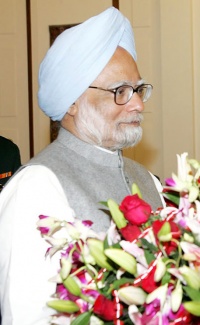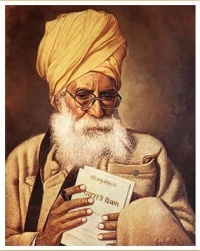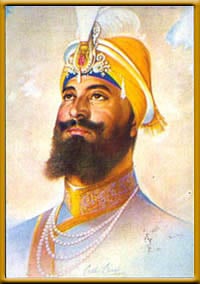Why I wear a Turban?
Most people in the west who wear the turban are Sikhs. All Sikhs, but particularly male Singhs are required to don the Dastaar due to the pronouncement in 1699 by the tenth Sikh master Guru Gobind Singh. Dastaar, is the native Punjabi term used to refer to this headdress. Even 300 years on, it is in compliance to the Hukam (or order) of this supreme Sikh leader that all Sikhs today wear the dastaar. It is in honour and obedience to this one person! The Sikh prime minister of India, Dr Manmohan Singh, displays his sky blue trademark turban out of respect for the Sikh Guru; the famous record breaking, 95-year-old marathon runner, Fauja Singh proudly wears his dastaar in honour of the tenth Sikh teacher; Bhagat Puran Singh the humble humanist and philanthropist used to don a simple turban in respect of the Sikh master. Why do the Sikhs go to all this trouble so many years after the diktat?

The dastaar comes in many different colours and styles and to the keen eye, each turban is different. Some are simple but regal; others may be bright and sporty; yet others may be stylish and extravagant – each one has it own special and unique statement. Every morning, most Sikh man and many Sikh women, spend some 5 to 20 minutes to comb their long hair and then carefully handcraft the link to their Gurus – a daily reminder of their heritage and its responsibilities. From the simple 4 to 8 metres of plain coloured cloth emanates a signal. The person is instantly elevated and recognised as different. The messages emanating from this simple piece of coloured cloth tied on the head can be so varied and so different depending on the creator of the garment. However, the reason and purpose behind this simple religious garment is extremely serious. For someone who has no clue about Sikh history and tradition, what follows will be a revelation and a real eye opener – a total surprise.
I will try and keep the history brief so that it does not distract us from the main theme of this article. In 1675 in old Delhi at Chandni Chowk took place a most horrific event that was to change the course of Sikh history and perhaps the course of Indian history. The most pious and benevolent leader of the common people of India, Guru Tegh Bahadar was beheaded in an open public place by the then rulers.

The reason for this barbaric act? The father Guru would not submit to their fanatical demands – that is, to renounce his faith and join with them in their religion. The ground shook and the winds roared as a display of anger at such a traumatic event – and that against a most saintly and loving soul.
When the son Guru, Guru Gobind Rai found out about this tragic occurrence, he ask Bhai Jaita who witnessed this event: "Wasn't there any Sikh in the crowd" – meaning wasn't there any brave people in the crowd who would have stopped such a tragedy from taking place. The answer that was received sealed the resurgence of the dastaar and the outward appearance of the Sikh.
Bhai Jaita, replied, "Guru Ji, many Sikhs must have been there in the crowd, but they could not be recognised" You see, in 1675, the Sikhs were not required to wear a turban. All the Sikh Guru's wore the turban but not all Sikhs were required to display the dastaar.

Guru Gobind Rai said, "Bhai Jaita ji, I will create the Khalsa, who will stand out in the crowd and who will never flinch from performing their duties whatever the odds."
Over the next 24 years, the Guru prepared the Sikhs to reach a high level of consciousness; to become brave and strong; to love truth and dharma more than pleasure and materialist gain. Then in 1699, he announced: "Saava lakh say ek laarrau, tabh Gobind Singh namh kaahaoo" – "When one will stand and fight 125,000, then I shall be called Gobind Singh" In those 24 years he transformed a passive, feeble and subservient people of India into a brave and fearless warrior people who were extremely courageous and valiant but at the same time were compassionate and just – a real Sant Sipahi - a "warrior saint".
From 1699 onwards, Guru Gobind Singh led from the front and taught the Sikhs how to master this balance of saintliness and gallantry; how to be compassionate and to fight for the weak; to be strong but humble. In showing his people how to follow the path of righteousness, he sacrificed most of his family; but he never wavered in his belief in truth and honesty right to the end. Never was his spirit defeated although all material and family relations were lost. He showed the world how to live and accept the Will of God. When most of his family was lost; two teenage sons lost in battle; two younger sons martyred by the rulers; mother dead – his spirit was not defeated – He remembered God, even when all wealth was gone; he barely had clothes on his back; most of his companions had perished in battle – What did he say to God – "God, I am not happy with you. I have never don't anything wrong. Why are you punishing me like this?" – Most definitely not!

This is the actual Shabad which he sang at the time:
| ਮਿਤਰ ਪਿਆਰੇ ਨੂੰ ਹਾਲ ਮਰੀਦਾ ਦਾ ਕਹਿਣਾ ॥
ਤਧ ਬਿਨ ਰੋਗ ਰਜਾਈਆ ਦਾ ਓਢਣ ਨਾਗ ਨਿਵਾਸਾ ਦੇ ਹਹਿਣਾ ॥ ਸੂਲ ਸਰਾਹੀ ਖੰਜਰ ਪਿਆਲਾ ਬਿੰਗ ਕਸਾਈਆਂ ਦਾ ਸਹਿਣਾ ॥ ਯਾਰੜੇ ਦਾ ਸਾਨੂੰ ਸੱਥਰ ਚੰਗਾ ਭਠ ਖੇੜਿਆ ਦਾ ਰਹਿਣਾ ॥ |
| mithr piaarae noo(n) haal mureedhaa dhaa kehinaa ॥ thudhh bin rog rajaaeeaa dhaa oudtan naag nivaasaa dhae hehinaa ॥ |
| Please tell my dear friend (God) the plight of his disciples.
Without You, comfort of rich blankets is a disease; living in a home like living with snakes. Our water pitchers are like torturous stakes and our cups have edges like daggers. Neglecting You, is like the suffering of animals at the hands of butchers. My Beloved's straw bed is more pleasing than living in costly furnace-like mansions. |
Remembering the Lord is more important than all the wealth and all relationships in the world! Guru Gobind Singh's contribution to the world has been unbelievable and proof of that lies in the millions of Sikhs who everyday wear his token on their head; to honour his life and remember the wonderful example that he set for the rest of us. May his memory live forever! Waheguru.

